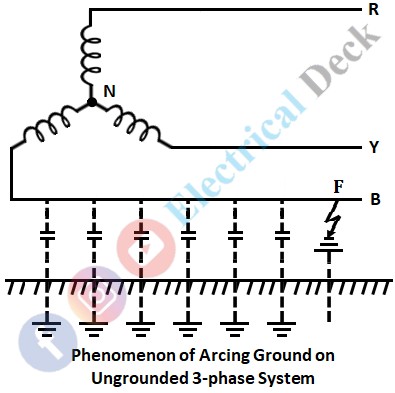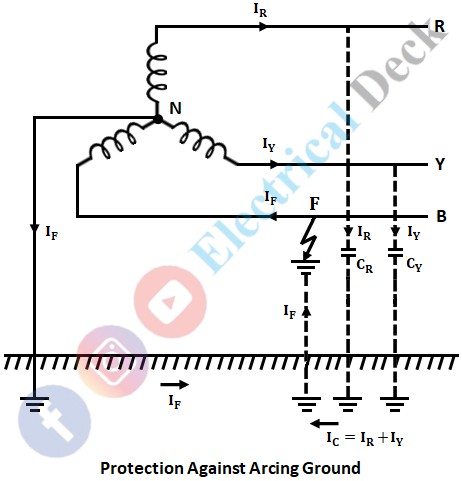Phenomenon of Arcing Ground :
Due to lightning surges, puncture of an insulator on an overhead line, falling of a branch, etc., an arc between the phase conductor and earth develops. The arc extinguishes and restrikes in a repeated regular manner. This phenomenon is known as arcing ground. As the arc path through the air will have high resistance, the arcing current is low. But due to arcing ground, the voltages of the other two phases will overshoot repeatedly.
Consider an overhead line of a 3-phase ungrounded system with an earth fault at point F on phase B as shown in the figure above. Each line of the system will have an inherent capacitance distributed throughout the line with respect to earth (shown in the figure above for phase B). Commonly this distributed capacitance is shown at one point of the line for simplicity.
When an earth fault occurs on any of the lines, the gap between the faulty conductor and the earth breaks down due to which the distributed capacitance of the faulty line discharges directly to the earth through the fault point (point F in figure).
This capacitance again will charge from the supply and again gets discharged to earth. The continuous charging and discharging of the line-to-earth capacitance results in the formation of repeated arcs between line and ground which is known as arcing ground.
Protection Against Arcing Ground :
Due to arcing ground, a temporary fault builds up into a permanent fault. Moreover, severe voltage oscillations reaching three to four times the normal voltage are produced because of arcing ground.
When an earth fault occurs in phase B at point F, then the fault current IF will be flowing from the fault point F to the neutral point N through the ground and back to the faulty phase as shown in the figure. IR and IY are the charging currents of phase R and phase Y respectively. IC is the resultant line-to-earth capacitive current of the healthy phases. The fault current will be in phase opposition with the charging current of the healthy phases and hence with the resultant line to earth capacitive current.
When the fault current is made equal to the resultant capacitive current by using a reactor or arc suppression coil in the neutral earth circuit, then the fault current will neutralize the resultant capacitive current or the capacitive currents of the healthy phases i.e.,


